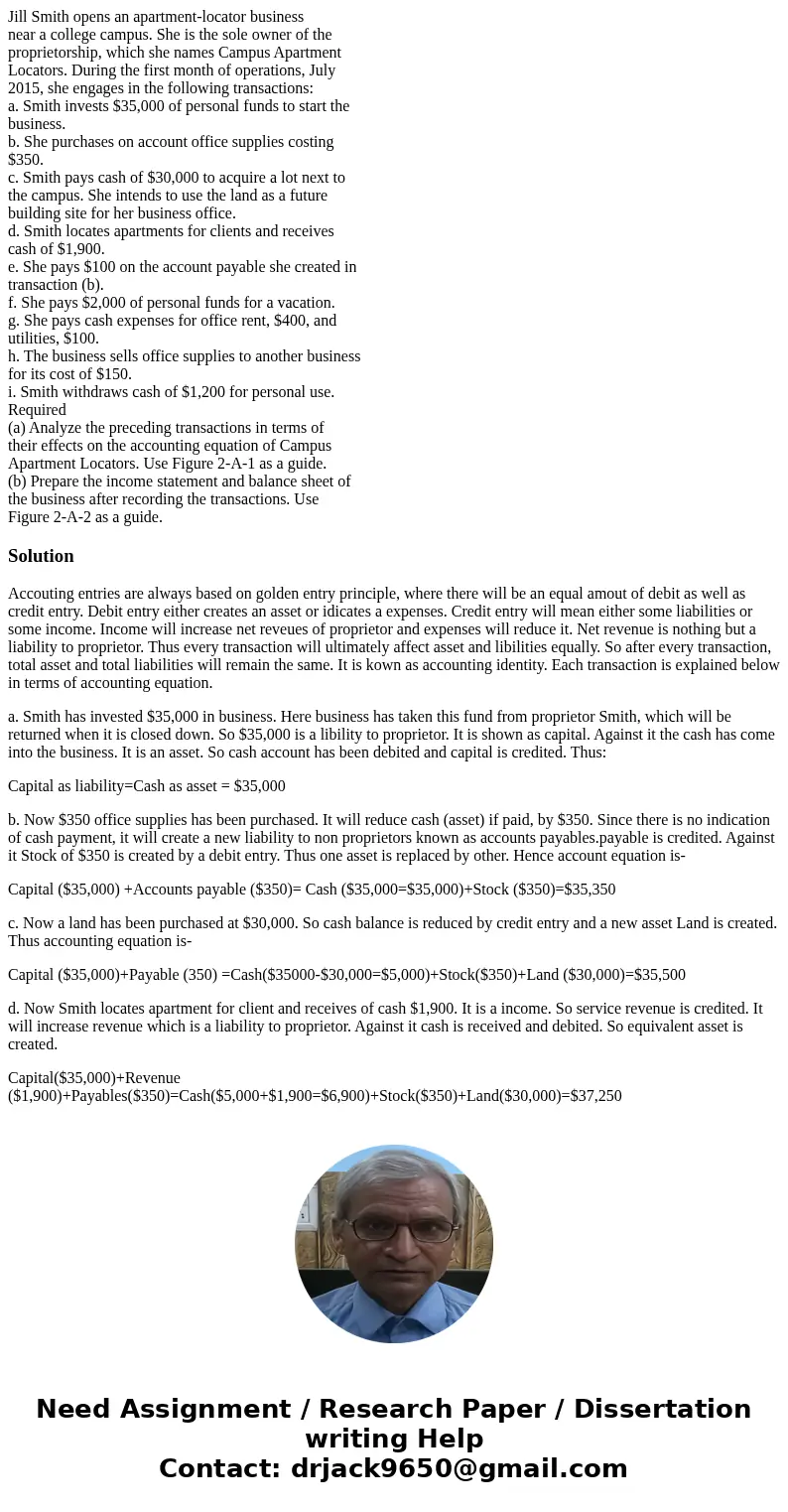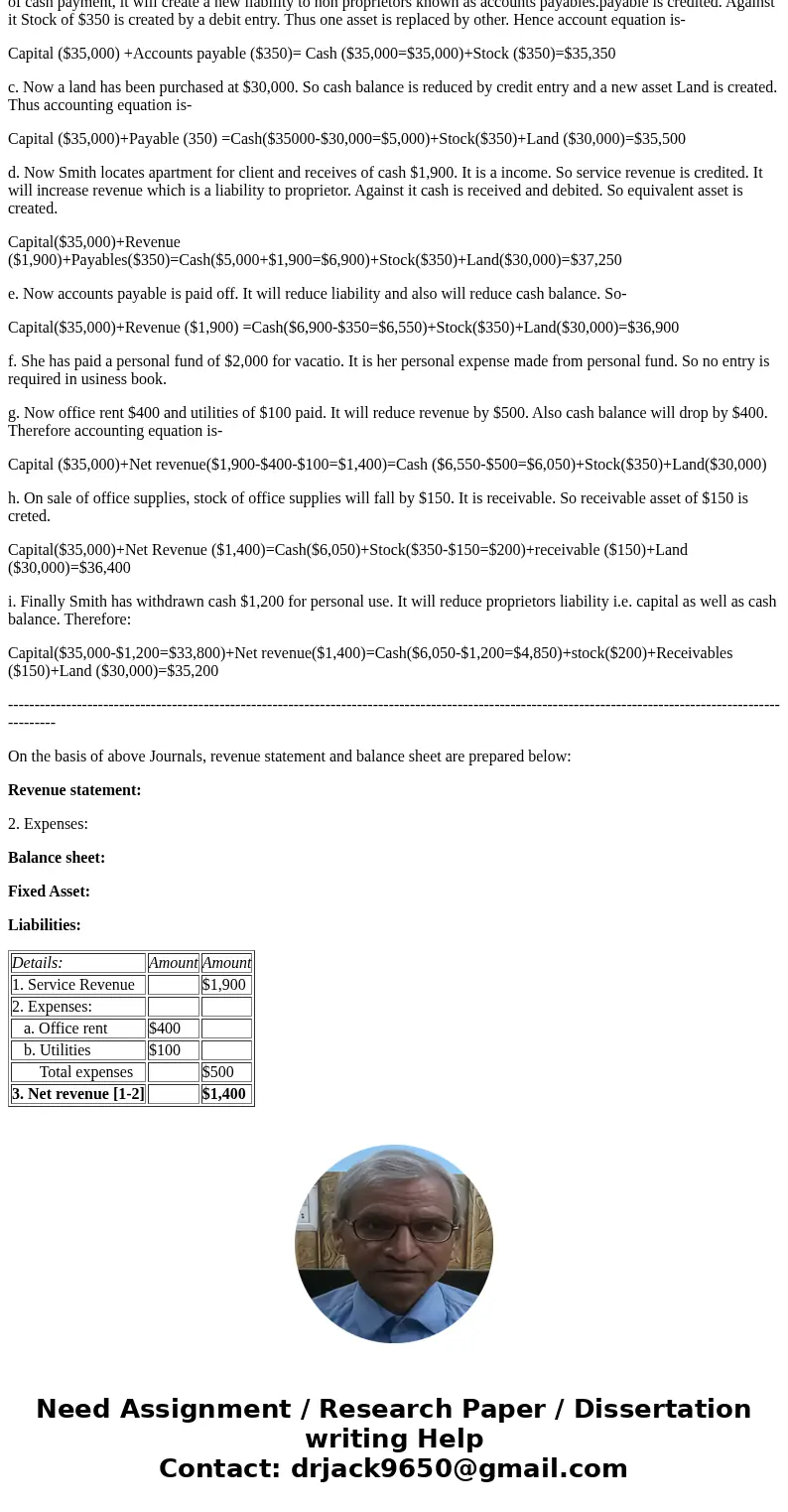Jill Smith opens an apartmentlocator business near a college
Jill Smith opens an apartment-locator business
near a college campus. She is the sole owner of the
proprietorship, which she names Campus Apartment
Locators. During the first month of operations, July
2015, she engages in the following transactions:
a. Smith invests $35,000 of personal funds to start the
business.
b. She purchases on account office supplies costing
$350.
c. Smith pays cash of $30,000 to acquire a lot next to
the campus. She intends to use the land as a future
building site for her business office.
d. Smith locates apartments for clients and receives
cash of $1,900.
e. She pays $100 on the account payable she created in
transaction (b).
f. She pays $2,000 of personal funds for a vacation.
g. She pays cash expenses for office rent, $400, and
utilities, $100.
h. The business sells office supplies to another business
for its cost of $150.
i. Smith withdraws cash of $1,200 for personal use.
Required
(a) Analyze the preceding transactions in terms of
their effects on the accounting equation of Campus
Apartment Locators. Use Figure 2-A-1 as a guide.
(b) Prepare the income statement and balance sheet of
the business after recording the transactions. Use
Figure 2-A-2 as a guide.
Solution
Accouting entries are always based on golden entry principle, where there will be an equal amout of debit as well as credit entry. Debit entry either creates an asset or idicates a expenses. Credit entry will mean either some liabilities or some income. Income will increase net reveues of proprietor and expenses will reduce it. Net revenue is nothing but a liability to proprietor. Thus every transaction will ultimately affect asset and libilities equally. So after every transaction, total asset and total liabilities will remain the same. It is kown as accounting identity. Each transaction is explained below in terms of accounting equation.
a. Smith has invested $35,000 in business. Here business has taken this fund from proprietor Smith, which will be returned when it is closed down. So $35,000 is a libility to proprietor. It is shown as capital. Against it the cash has come into the business. It is an asset. So cash account has been debited and capital is credited. Thus:
Capital as liability=Cash as asset = $35,000
b. Now $350 office supplies has been purchased. It will reduce cash (asset) if paid, by $350. Since there is no indication of cash payment, it will create a new liability to non proprietors known as accounts payables.payable is credited. Against it Stock of $350 is created by a debit entry. Thus one asset is replaced by other. Hence account equation is-
Capital ($35,000) +Accounts payable ($350)= Cash ($35,000=$35,000)+Stock ($350)=$35,350
c. Now a land has been purchased at $30,000. So cash balance is reduced by credit entry and a new asset Land is created. Thus accounting equation is-
Capital ($35,000)+Payable (350) =Cash($35000-$30,000=$5,000)+Stock($350)+Land ($30,000)=$35,500
d. Now Smith locates apartment for client and receives of cash $1,900. It is a income. So service revenue is credited. It will increase revenue which is a liability to proprietor. Against it cash is received and debited. So equivalent asset is created.
Capital($35,000)+Revenue ($1,900)+Payables($350)=Cash($5,000+$1,900=$6,900)+Stock($350)+Land($30,000)=$37,250
e. Now accounts payable is paid off. It will reduce liability and also will reduce cash balance. So-
Capital($35,000)+Revenue ($1,900) =Cash($6,900-$350=$6,550)+Stock($350)+Land($30,000)=$36,900
f. She has paid a personal fund of $2,000 for vacatio. It is her personal expense made from personal fund. So no entry is required in usiness book.
g. Now office rent $400 and utilities of $100 paid. It will reduce revenue by $500. Also cash balance will drop by $400. Therefore accounting equation is-
Capital ($35,000)+Net revenue($1,900-$400-$100=$1,400)=Cash ($6,550-$500=$6,050)+Stock($350)+Land($30,000)
h. On sale of office supplies, stock of office supplies will fall by $150. It is receivable. So receivable asset of $150 is creted.
Capital($35,000)+Net Revenue ($1,400)=Cash($6,050)+Stock($350-$150=$200)+receivable ($150)+Land ($30,000)=$36,400
i. Finally Smith has withdrawn cash $1,200 for personal use. It will reduce proprietors liability i.e. capital as well as cash balance. Therefore:
Capital($35,000-$1,200=$33,800)+Net revenue($1,400)=Cash($6,050-$1,200=$4,850)+stock($200)+Receivables ($150)+Land ($30,000)=$35,200
-----------------------------------------------------------------------------------------------------------------------------------------------------------
On the basis of above Journals, revenue statement and balance sheet are prepared below:
Revenue statement:
2. Expenses:
Balance sheet:
Fixed Asset:
Liabilities:
| Details: | Amount | Amount |
| 1. Service Revenue | $1,900 | |
| 2. Expenses: | ||
| a. Office rent | $400 | |
| b. Utilities | $100 | |
| Total expenses | $500 | |
| 3. Net revenue [1-2] | $1,400 |


 Homework Sourse
Homework Sourse